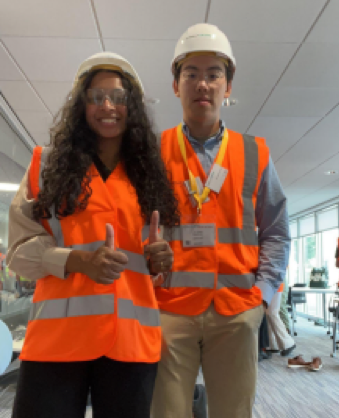Students Tour Siemens Gamesa and the Aura Innovation Centre
July 14, 2023
After a chaotic arrival in Hull, the UNC Burch sustainability group kept moving with a packed second day! Our group started our morning with a quick birthday breakfast, celebrating Sarah Roger’s 21st. We enjoyed both the delicious hotel buffet, along with Krispy Kreme donuts. Soon after, we piled into a bus and traveled to our first stop, Siemens Gamesa, a renewable energy leader focusing on the development of wind turbines.
Upon arrival, we were given PPE and watched a safety brief to ensure our well-being during the facility tour. To help orient ourselves, we received an explanation of the facility’s structure, using the factory map as a visual aid. Inside the production site, we looked at a variety of materials. One of the most notable things we witnessed was the making of a wind turbine blade. This curved blade was 108m long, designed to be “straightened out” by high velocities. I found it particularly interesting how the creative process reflected the building’s architecture. When constructed, turbines are held together by a chemical substance, resin. The resin must be injected into each blade, which generates a substantial amount of heat. Due to this, the buildings were designed without a heating system to account for the excess produced, thus lowering energy costs and increasing energy efficiency.
Following this, we ventured into the blade restoration area, where we learned about the repair procedure. This vicinity was mostly used for correcting manufacturing defects. The most prevalent issue engineers face is adjusting the geometry of the blade; the blade is ground down with sandpaper and refilled with resin so it can be molded into a functional shape. If done correctly, each full turn of the blade will generate enough energy to power a house for two days. Within this space, we saw both the root of the blade and the backbone of the turbine. Finally, we stopped at the painting warehouse, where the blades are coated. We learned about the toxic chemical components, the health dangers associated, and how staff properly equip themselves to ensure safety. If these safety protocols are followed, painting a turbine easily becomes the least hazardous process.
Following our tour at Siemens Gamesa, students arrived at the Aura Innovation Centre, an incubator space that promotes “knowledge exchange,” or the exchange of facts and ideas among researchers, industry, university officials, and government. Rather than doing research simply to acquire new knowledge, those that work at Aura want their work to accelerate real, sustainable policy and industry change. To accompany a tour of the facility, Jim Gilbert gave students an overview of offshore wind technologies and logistics which further expanded our understanding of offshore wind as a whole. I was surprised to learn that offshore wind turbines can actually have a positive impact on oceanic biodiversity, as lobsters often like to live along cable lines and sea birds feed behind the turbines due to uplifted nutrient cycles. Although this is not the whole story when it comes to offshore wind’s impact on sea life, I still believe spreading these facts might help get more people in support of offshore wind. The last activity of the day was a walking tour of Hull (officially known as Kingston upon Hull due to its history under the reign of King Edward who renamed it). Our guide, Paul Schofield, was a lively, joke-cracking Englishman who, as someone who’d lived his entire life in Hull, was able to tell us about the unique quirks of the city. For example, the city was named the UK’s ‘City of Culture’ in 2017, in addition to having an engraved stone fish trail that goes all around the city. As we walked, I noticed a fun mix of modern architecture, showcased with Hull’s Aquarium “The Deep,” and the old medieval charm of the cobblestone streets and church. I can only imagine that with the rapid expansion of offshore wind, and thus blade manufacturers like Siemens Gamesa, Hull will continue to attract new talent that will further transform the city into a future-oriented innovation hub.

About the Author
This article was written by:
Nicky Coursey, https://www.linkedin.com/in/nicole-coursey-093512252/, Environmental Studies ’26
Sanjana Venkatraman, https://www.linkedin.com/in/sanjanasvenkatraman/, Environmental Science, ‘25

